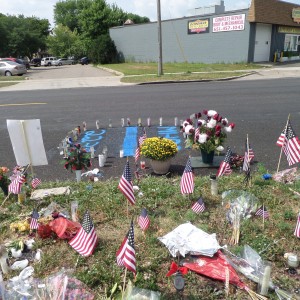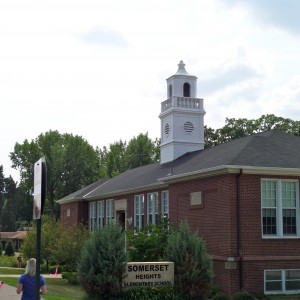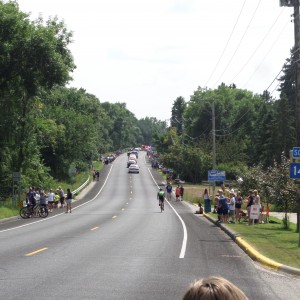#922 – Dick Bernard: "Officer down", A Family and a Community Tribute
UPDATE: Commentaries about Ferguson MO can be found here.

Where Officer Patrick was slain, on Dodd Road, at intersection with Smith Avenue in West St. Paul, MN. Scene as it appeared after the funeral August 6, 2014
Yesterday I participated in the Memorial for Scott Patrick, the policeman who was killed during a routine traffic stop on July 30. I was simply one of those who stood along the route of the procession from funeral to cemetery in Mendota Heights MN. I viewed the procession at Somerset Elementary School, where my daughter, Joni, new Principal there, was one of those who rang the school bell as the police cars, and then the family procession, moved past.
It was a very moving near four hours. Todays news will be full of accounts in the local papers. Simply enter in your internet search box, Scott Patrick Mendota Heights Policeman funeral August 6, 2014.
The killing of Officer Patrick by someone he’d pulled over at a routine traffic stop made absolutely no sense. The officer was a person who liked people. His “alleged” killer, who has admitted killing the officer, volunteered he “hates cops”.
The one post that I most noticed on the day that the officer was killed was this late afternoon July 30 Facebook post from my daughter, Joni, a school Principal in Officer Patrick’s town:
“Officer Patrick would often visit Friendly Hills Middle School when his shift was during school hours just to check in, say hello, and make sure all was well. I am proud to have had the opportunity to know and work with him. Although I don’t live in Mendota Heights, our lights will be on to honor Officer Patrick and all those who daily put their lives at risk to protect us all.”
It was clear, both from Joni’s note and the service that Officer Patrick was an ordinary guy, who was, like so many ordinary people, very extraordinary. Just someone who did his job.
I took a few photos between 11 a.m. and 3 p.m. while at Somerset Elementary School on the funeral cortege route. They follow, and after them, a short comment, and a proposal a friend sent me back in April, which seems now to be most appropriately presented.
The police cars I most noted? Park Rapids MN (where I’ll be, at my sisters, later today); Airport Police (where two of our family are Police); an Iowa State Patrol car (noting a long ago relative who was among the first 50 state highway patrolmen in Iowa, in the 1930s.) There were police from almost everywhere; from Chicago to Bismarck; and police from all conceivable sectors, including the police cadets from Hibbing MN. It was huge outpouring of support of the Law Enforcement family.
The photos (click to enlarge):

The bell tower of Somerset Elementary in Mendota Heights. The bell tolled for the entire hour that funeral procession vehicles passed by the school, including the estimated 4000 policemen and women honoring their fallen colleague.


The last vehicles in the funeral procession disappear, nearly two hours after the first car had passed by (1 p.m.)
Words aren’t adequate at such times as yesterday afternoon.
A young man, standing near by, audibly said “thank you” to the policeman passing by in their vehicles. He must have said those words, with feeling, hundreds of times.
Also near me, yesterday, was a nice but very serious young man, perhaps early 40s, who stayed the entire time and looked very serious and respectful. At one point we visited a little. Turned out that years ago a friend of his was the subject of the killers already vicious anger. What happened is irrelevant. “I suppose you’re against the death penalty”, he said.
“Not necessarily”, I noted, but I also noted that mistakes are made.
The killing of the officer was an act of impulsive anger. Is it an appropriate response to then try and kill the killer, however reprehensible he might be? I’d submit that there should be no easy answer to that question.
I could very well understand the young man’s anger, and I felt that the young man and I weren’t seriously at odds, nor even completely disagreeing. It was an important, brief, conversation, however, one of many we all should have.
COMMENTS:
Judy B, Aug. 7
Very nice post, Dick. I can’t remember a time when I was more touched by a news story. This one pierced my heart — perhaps because somehow you just knew he was a nice guy. Perhaps because he had two beautiful daughters who lost their dad. Perhaps because he had such a gracious wife. I wept every time I read a new story. This morning’s Strib, with its headline, “Calling Badge 2231..Officer Scott Patrick is out of service…” had me blubbering.
But I was also touched by the comment of my neighbor, a retired social worker, who said, “why didn’t someone help that man (the killer) long ago? Obviously, he fell through the cracks.” Not a very popular comment at this tender time, but an astute one.
Bob S, Aug 7
I read or heard something to the effect that in MN we only have 5 investigators working on 5000 cases of criminals who have vanished from the radar, that is not reporting to a probation officer or complying with the conditions of probation or parole, thus are in violation of the terms of freedom from jail, and who therefore would be considered wanted and often dangerous. The reason for this under-staffing has been budget cuts going back to Pawlenty. I notice Mayor Coleman in St. Paul is cutting back on all kinds of vital services, including public safety services (police-fire etc) and public works (pot holes). The mantra, cut taxes and government, is coming back to haunt us, and the right blames government.
David T., Aug 7:
read your blog piece on the killing of Officer Scott Patrick. Well done. I think the thing that brings out such an outpouring of grief and support any time one of these events happens is that we see the police as a kind of wall between the forces that would destroy the fabric of society and those who go about our lives dependent on that fabric remaining intact; the proverbial “Thin Blue Line,” if you will. A murder of a police officer feels so much more personal and existential than the myriad murders that are way-too common place.
It’s easy to understand the desire for revenge any time one of these horrific crimes occur. The death penalty certainly would be the ultimate act of revenge. Certainly there can be no other reason to impose it on the perpetrators of these acts. I doubt that the officer’s killer would have thought better of pulling the trigger had he been in a state that allows capital punishment. Maybe some of us would get a feeling of satisfaction in seeing the ultimate penalty imposed, but, in the end, I think there’s a larger price to pay when we empower the state, on our behalf, to have this power.
Which leads, finally, to the proposal, made a couple of months ago, by a good friend, Grace Kelly, in St. Paul, a person who respects and likes police, but also recognizes that there are occasional individual and system problems.
I present her words exactly as she wrote them, as a draft, for thought and discussion by others in other contexts.
Grace Kelly, May 27, 2014
Here is the proposal that we discussed over the phone, in rough draft form. Since I tend to procrastinate, I am sending this out now. Please feel free to forward as you wish.
I believe that the standards of peace and nonviolence start with what happens in our own backyards. Peace cannot exist without justice. In our own community, we have had instances of an unarmed suspect of a non-violent crime being shot 5 times in the head and 2 times in the back by law endorsement officers. We also have officers who go unrecognized and unsupported when they risk their own lives to safely arrest people.
I would propose that there be four yearly grand awards, that are awarded after the previous year numbers are out, probably in June of following year.
1) 2014 Best Community Policing supporting Standards of Peace and Non-violence for a Force of 100 Sworn Officers or Higher
2) 2014 Most Improved Community Policing supporting Standards of Peace and Non-violence for a Force of 100 Sworn Officers or Higher
3) 2014 Best Community Policing supporting Standards of Peace and Non-violence for a Force of Less than 100 Sworn Officers
4) 2014 Most Improved Community Policing supporting Standards of Peace and Non-violence for a Force of Less than 100 Sworn Officers
I think this should be limited to just Minnesota because the research is difficult. Nominations could come from any peace activist or by self nomination of the particular police force. The police forces must be government paid. University or transit police could qualify.
In addition to the four grand awards, I would add a certificate level of recognition. For all nominated police forces, I think we should recognize three levels of achievement. No recognition is also an option.
Gold – Instances of some tough challenges with some outstanding achievement. Good overall performance.
Silver – Overall good performance. May have a few successes and a few challenges.
Bronze – A department marked by improvement although challenges may still exist.
No recognition – Even though there may be good noteworthy instances, the department has a culture as a whole that could be described as militaristic policing
In evaluating instances, what the department does to individuals after a good and bad instances has to be considered. A department that encourages retirement, assigns desk work, doles out censure and assigns parking patrol for bad instances is enforcing peace standards.
Standards for Community Policing
1) Respect for protest and all civil rights – Inspect instances where the police actively protected civil rights vs harassment for those who wish to speak out. An example of contrary evidence would be the Minneapolis police arresting Occupy protestors for stepping into the street. Other examples of contrary evidence are the numbers of obstructing justice and similar broad stroke charges. Are people allowed to video record police activities without harassment? Allowing observation and recording would be positive evidence.
2) Patrolling, investigation and prosecution across all economic and social divisions. Were rich people investigated? Does the arrest and conviction record reflect the social and economic diversity of the unit being served. If not, why not? Is just one type of crime persecuted? Are there areas of crime that are off limits?
3) Safe arrests and safe detainment. Community police specialize in arresting people safely without any injury. This even includes drug or mental conditions. Jails should keep people safe. People should be able to dress and eat within jails in a way that respects religious or ethical beliefs. For example, vegetarians should have meals without meat.
4) Community Involvement – Does the force actively reach out and engage with the community. How do everyday people feel about their force? Is there respect and courtesy? Is there fear? Do officers live and volunteer within the community? Are there force actions that go beyond the minimum? What kind of language and words are used in communications? Do officers reflect the diversity of the community?
5) Law Enforcement Effectiveness – How well does the department or office do its job? Peace cannot come without justice.
6) A Focus on Building Community not Just Increasing Prison Populations – Law Enforcement has a great opportunity to change direction of lives if diversion programs are used for first-time offenders or teenagers. Does the force use its ability to change lives for the better?
More background is in these articles: here and here.
Peace begins at home.
Grace Kelly nicknamed Kelly
651 246 6717




Leave a Reply
Want to join the discussion?Feel free to contribute!